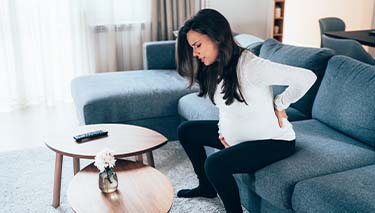Pelvic girdle pain in pregnancy is another one of those uncomfortable by-products of growing a little person towards maturity. Although your baby will be none the wiser about your discomfort, you'll be reminded about their presence each time you go to stand, sit, lie down or even go for a walk. And when they choose to change their position a bit and find a more comfortable way to lie, you're likely to be doing the same thing as well.
Other names for pelvic girdle pain are pelvic or pubic symphysis instability. These are all alternatives when talking about the pain and instability of the joints and bones at the front and back of the pelvis. Sometimes women with pelvic girdle pain also experience low back pain in pregnancy.
But I've never heard of a pelvic girdle!
This is an important part of every person's anatomy, but particularly women and even more so when they are pregnant. The pelvic girdle is a network of muscle and ligament structures which transmits weight between the upper and lower back and helps to maintain trunk stability. Studies have shown that up to 33% of pregnant women will experience some degree of pelvic girdle pain or pelvic instability. Having a good balanced posture and muscle actions which work in synchronicity with each other help the pelvic girdle to work most effectively.
Studies have also shown that women who have increased pelvic floor muscle tension tend to experience more tenderness and pain in their pelvic girdle. Strengthening exercises may only make this worse as the muscles are already too tight. But exercises which help with motor control and learning how to move and then relax are much more useful.
What does pelvic girdle pain feel like?
Each woman has her own individual interpretation of the pain. Though common words to describe it are: stabbing, dull, shooting or even a burning pain. This pain can extend from the front of the pubic bones right through to the back, across the buttocks and down the back of the legs and even down the thighs.
The pain is often worse on movement, particularly when walking, climbing stairs, getting up out of bed and/or the car. Some women can actually feel (and hear) a clicking or grinding sound from the pubic bone at the front. After periods of standing still for any length of time, this can be worse.
What causes pelvic girdle pain?
- An increase in the pregnant mother's weight. Of course, some weight gain is inevitable but an excessive increase during pregnancy adds to the risk of developing problems.
- Changes in her centre of gravity as the stability of the pelvis is affected.
- Strenuous, repetitive or jarring type physical work and activity.
- Previous injury or trauma.
- Being overweight with an increased BMI.
- The effect of pregnancy hormones, in particular Relaxin which relaxes the muscles and ligaments in preparation for labour and childbirth.
- Posture and exercise routines.
- The lie or position of the baby.
- The overall quality of the mother's connective tissue impacts on the stability of her pelvis.
What you can do to relieve pelvic girdle pain
First of all it's important that you are properly assessed by your maternity care provider. You may benefit from a referral to a specialist obstetric physiotherapist who can offer you specific, targeted exercises. It could also be useful to see an occupational therapist who specialises in pregnancy support.
- Avoid pushing through your pain. Take it as a sign that you need professional assessment and management before it becomes worse.
- Avoid taking long strides when you are walking and instead, take shorter steps.
- Try not to walk too far. Although it is good for you overall, walking can exacerbate pelvic instability.
- Rest when you can.
- Investigate you options of wearing a support garment or belt which will decrease your sacroiliac joint movement. You may even need to wear this to bed as long as it isn t too tight.
- Avoid sitting down with crossed legs.
- Engage your pelvic floor muscles before you cough, sneeze or laugh.
- Sit on chairs which have a back rather than stools and use a cushion to support your lower back.
- The discomfort can be made worse by straddling positions such as with bike riding or intercourse. This tends to open up the sacroiliac joint even further.
- Sleep on your side with pillows to support your upper leg and tummy.
- Avoid doing exercises which involve bouncing up and down on one leg or foot.
- When you are getting up out of bed, keep your knees together.
- Sit down to put on underpants, trousers and when doing up your shoes.
- Avoid wearing high heeled shoes and instead, wear ones which have a low heel and some arch support.
- You may need to consider using crutches or a wheelchair if needing to walk long distances.
- Speak with your physiotherapist about trigger points where you can massage to release tension and tight muscles.
What else can I do about pelvic girdle pain?
- Belly bands can help with pelvic support and help to break the pain cycle. However, there's no evidence that they are effective during pregnancy. The actual cause for the pain needs to be identified and then effectively managed and treated.
- It is important to be individually assessed as there is no one consistent set of messages which apply to all women with pelvic girdle pain.
- Pelvic floor muscle releases and an increase in pelvic floor awareness.
- For some women acupuncture can be very effective in relieving pain.
- A support garment such as a sacroiliac belt may help to relieve discomfort.
- Relaxation exercises can be very helpful.
- Water based exercises, acupuncture and targeted physiotherapy preferably by a women's health physiotherapist or one who specialises in pelvic floor dysfunction.
- A gentle exercise programme such as swimming can help to reduce symptoms. Being fully supported by the water helps to alleviate symptoms as well.
- You may benefit from taking analgesics and/or anti inflammatory medication, however speak with your maternity care provider first. Some medications are contraindicated during pregnancy (and lactation) even though this may not be clear on the labelling.
- Daily programmes of exercises which include gentle stretching and strengthening regimes can be provided by a physiotherapist. Look for one who has specialised training and expertise in women's health and/or pregnancy.
Check Hold it Mama The Pelvic Floor & Core Handbook for Pregnancy Birth & Beyond. By Mary O Dwyer RedSok Publishing.
Last Published* May, 2024
*Please note that the published date may not be the same as the date that the content was created and that information above may have changed since.





















